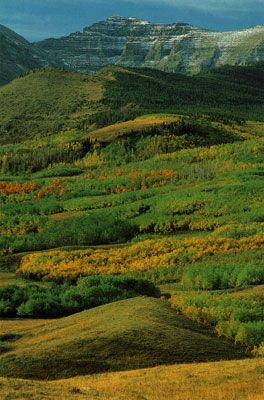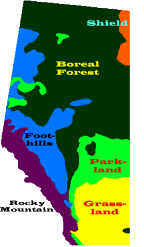Parkland Region: Alberta, Canada
With a moister climate than the grassland regions to the south, small streams and wetlands abound; bluffs and aspen and balsam poplar offer shelter and the rich black soil produces bounteous crops. The rolling terrain and abundant sloughs sustain large numbrs of waterfowl. In the few places where native parkland survives, deer abound, Baird's sparrows sing their rich song from grass tussocks and red-tailed hawks circle in the afternoon thermals. The mosaic of aspen forest, fescue grasses and wetlands sustains a rich diversity of plant and animal life. Most of the original aspen parkland survives only in small fragments because few farmers can afford to leave large tracts of original parkland intact. And, fires, which are integral to parkland ecology, are suppressed, changing the natural vegetation mosaic. Today, less than 5 percent of Aspen Parkland remains in its native state. There are three sub-regions of parkland: central parkland, Peace River parkland, and foothills parkland.
The most fragmented sub-region is the unique Peace River Parkland, which John Macoun visited in 1875: "West of the mountains, the climate was cold and moist and the land generally covered with a coniferous forest, but here we found prairie and aspen forest and a climate dry and warm. Here, 3,000 feet above the sea, the mountains are actually without forest and covered with grass and vetches over two feet high ..." Today there are very few uncultivated areas where the landscape Macoun described survives in anything close to its original state. The largest remaining site is near Grande Prairie, but it's only one square mile in size. The central parkland
sub-region reaches in a wide arc from Airdrie, to a point north of Edmonton and
east to Lloydminster and Provost. Today it's a checkerboard of of cropland with
a few surviving patches of original parkland in the Wainwright area, the Neutral
and Bodo Hills and the Sounding Lake sand plain.
|
|
Want to help protect the Rocky Mountains? Join or Make a Donation to an Organization that makes a difference. |
Foothill Region |
Grassland Region |
Mountain Region |
|
Shield Region |
 The
Parkland Natural Region is one of Alberta's richest agricultural regions and comprises
about 12 percent of Alberta. It offers rich and varied scenery.
The
Parkland Natural Region is one of Alberta's richest agricultural regions and comprises
about 12 percent of Alberta. It offers rich and varied scenery.  The
foothills parkland, shown in the photo on this page, has survived the best
of all parkland sub-regions thanks to shallow soils and a climate less favorable
to farm crops. It is a mix of aspen forest, patches of grasses, spruce and willow
shrubbery and strectches along the foothills from Cremona south to Waterton Lakes
National Park. It remains largely unprotected.
The
foothills parkland, shown in the photo on this page, has survived the best
of all parkland sub-regions thanks to shallow soils and a climate less favorable
to farm crops. It is a mix of aspen forest, patches of grasses, spruce and willow
shrubbery and strectches along the foothills from Cremona south to Waterton Lakes
National Park. It remains largely unprotected. 


